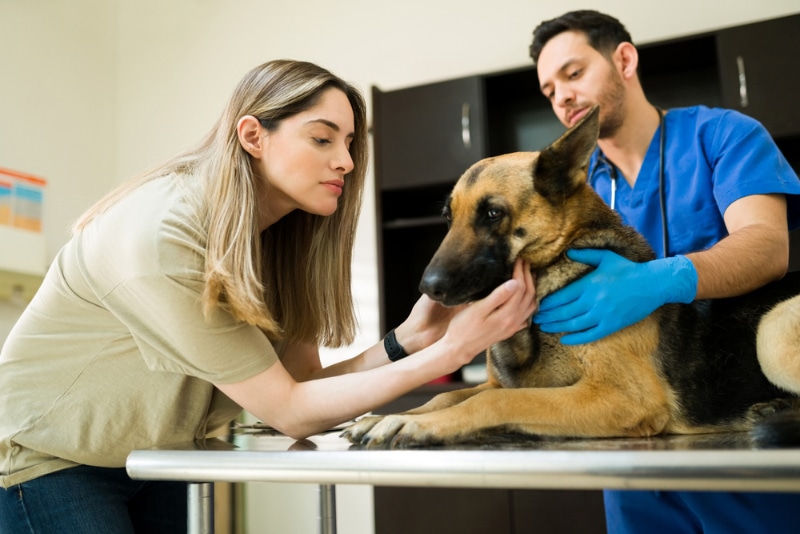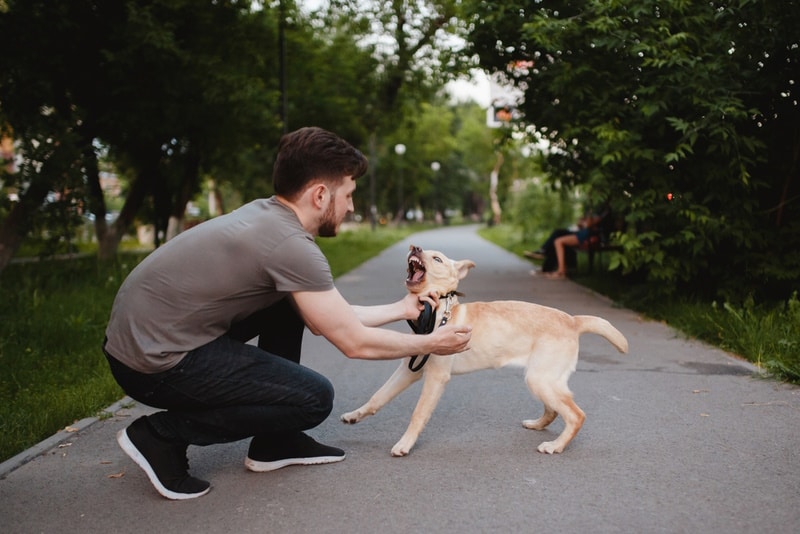Click to Skip Ahead
Dogs that are aggressive or reactive pose a serious risk to owners and members of the public. There are currently limited options for treating these dogs medically. Most attempts to help these dogs are made using behavioral management strategies. It has been suggested that Prozac, also known as Fluoxetine, can be helpful in the management of some cases of reactive and aggressive dogs.
Typically, the most positive outcomes occur when the drug is used in conjunction with training and behavior modification techniques. It is very important that owners are aware Prozac must only ever be used for dogs if it has been prescribed by a vet, and only at the recommended dose and frequency. Prozac prescribed for humans should never be given to dogs.

What is Prozac?
Prozac, which also goes by the generic name of Fluoxetine, belongs to a class of drugs called selective serotonin reuptake inhibitors (SSRIs). The main effect of Prozac is on the levels of a brain chemical called serotonin. Serotonin has an important role in the regulation of anxiety and fear. Prozac causes an increase in levels of serotonin.
- Depression
- Obsessive-compulsive disorder (OCD)
- Bulimia nervosa (eating disorder)
- Panic disorder
- Premenstrual dysphoric disorder (PMDD)
Uses of Prozac in Dogs
Prozac causes an increase in levels of serotonin in the brain. Serotonin in humans is responsible for the regulation of mood, and the reduction of anxiety and fear. These are often underlying causes of fear and anxiety in dogs.
Prozac is thought to lower the reactivity threshold. Dogs that are prone to reactivity and aggression could have a constant hyper alert state, which can cause them to overreact to stimuli in their environment. Prozac can help to increase their threshold for reactivity. This means they are less prone to extreme reactions and aggressive behavior.
It has been suggested that Prozac can help dogs to learn things while being trained. If a dog is not as anxious and reactive, they will be able to focus better on what they are being asked to do. This is especially relevant for behavior modification training, as this is often carried out in conjunction with the use of Prozac. Prozac can make training more effective which can cement positive long-term behavioral changes.

Cases That Could Benefit from Prozac
Prozac cannot be used for all behavioral issues in dogs. There are certain scenarios where it will not help and should not be used.
- If their aggressive behavior stems from fear-based reactivity or generalized anxiety, Prozac may help. This is because it will reduce their overall anxiety levels and enable them to cope with triggers more calmly.
- Impulse control—it is thought that Prozac may be able to help dogs that exhibit aggressive tendencies due to poor impulse control.
- Dogs that are already having behavioral modification training. Prozac will work well if used alongside behavioral training that addresses potential triggers and teaches more positive behavior.
- Not a magic cure-all—it is important that owners are aware it is not possible to commence Prozac and expect to see results immediately. Prozac should never be used on its own. It should only be prescribed in conjunction with behavior modification training by a fully qualified professional.
- As with all drugs, there are potential side effects. Some dogs will experience none of them, others will suffer badly and will not be able to use the medication. Prozac is generally well tolerated; however, all dogs react differently and it is inevitable some will experience side effects.
- Owners can become frustrated when using Prozac as it can take a few weeks before any positive results are seen. Vets can manage owners’ expectations by advising them that they will not see noticeable results immediately.
- Requires veterinary instruction and monitoring.
Prozac will only be prescribed after a qualified vet has diagnosed a specific behavioral issue and decided that Prozac is the most appropriate drug. They will also ensure that there is no other alternative that is licensed for use that may be more suitable. It is important that your dog is monitored and has regular vet checks throughout their treatment. This is a big commitment that some owners may struggle with.

How is Prozac Given to Dogs?
Prozac is usually given orally to dogs. This can be in a tablet, capsule, or liquid form. Your vet will prescribe a specific dose and advise you of the frequency to give the dose. You must follow these instructions. Liquid doses must be measured carefully as it is very easy to under or overdose.
It is important to not stop using Prozac abruptly unless your vet has told you to do so.
Prozac can be given on an empty stomach. If your dog vomits after being given Prozac, speak to your vet as they may advise you to give the drug on a full stomach after a meal.
Side Effects of Prozac in Dogs
As with any medication, Prozac can have potential side effects.
- Reduction in appetite. This is commonly seen in dogs and may need to be taken into consideration if the dog is underweight or generally has a small appetite. This side effect can improve over time.
- Lethargy. Some dogs will have decreased energy levels and sleep more when they first start the medication.
- Changes in sleep patterns. This can be an increase or a decrease in the amount they are sleeping or difficulty in falling or staying asleep.
- Vomiting. Some dogs can experience nausea and vomiting in the first few weeks.
- Diarrhea. Some dogs can experience other gastrointestinal upset such as loose stools or diarrhea.

- Skin issues including thinning of the fur, itching, and inflammation of the skin.
- Prozac has been reported to cause aggressive behavior and restlessness in a few cases. This is a very rare occurrence.
- A very uncommon occurrence again, but seizure activity has been reported. This can be seen more frequently in dogs with a history of epilepsy.
Side effects will vary greatly between individual dogs. Owners must monitor their dogs closely when starting on Prozac and be aware of the potential side effects to watch out for. If you see any signs of adverse reactions, contact your vet immediately.
Cases Where Prozac Might be Contraindicated
Prozac has many uses in dogs and is often a valuable addition however, it is not suitable for every case.
- Pregnant or lactating dogs. Prozac can potentially be harmful to unborn puppies and nursing bitches.
- Dogs with kidney or liver disease. These organs are responsible for the metabolism and elimination of many drugs and if they are not working properly, there is a risk of complications.
- Dogs with a heart condition. If your dog suffers from a heart condition it is not recommended to use Prozac. This is because it can cause the heart to beat faster and it can cause an irregular rhythm which can be very dangerous.
- If your dog has epilepsy or a history of seizures. Prozac can lower the threshold for seizure activity, which can increase the risk of a seizure occurring.
- Dogs on certain medications. There are some medications that dogs should not be taking if they want to take Prozac as they will interact with each other. This can include other SSRIs and other drugs such as MAO inhibitors. If your dog is on heart or seizure medication Prozac should also be avoided. Your vet should be informed of all the medication your dog is currently on or has recently been on before Prozac is considered.
- Severely aggressive dogs. If a dog is completely unmanageable, perhaps due to trauma in the past, Prozac may not be the drug of choice.
- Dogs that have had no previous training. If a dog has had no training in their life, and does not follow even basic commands, such as sit and stay, Prozac is unlikely to work. Prozac will make them more receptive to training but if they have not been trained in the first place, the drug will not be effective.

Conclusion
Prozac is a very useful prescription medication that can aid in the correction of reactive and aggressive behavior in dogs. Prozac should only ever be used under the supervision and guidance of your vet. Your vet will be able to assess your dog’s individual needs and determine the most appropriate dose.
It is important to remember that Prozac is not an instant cure for reactive or aggressive dogs. This is a complex situation that takes time and requires a multimodal approach. Prozac typically takes a few weeks to start working and it can be even longer before owners notice any visible results. Side effects can occur, and dogs should be closely monitored while on the medication.
If you have concerns about your dog’s behavior, your vet should be your first port of call.
Featured Image Credit: Parilov, Shutterstock










